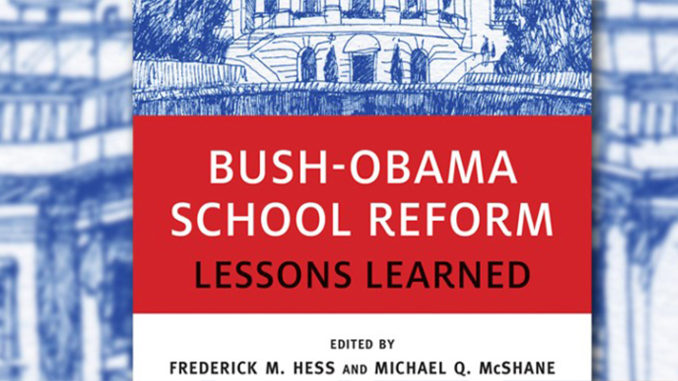
Why did initially promising, seemingly popular efforts at federal leadership lose their luster?
On December 10, 2015, as he signed the Every Student Succeeds Act (ESSA) into law, President Barack Obama hailed the bill as a “Christmas miracle.” ESSA had sailed through the U.S. Senate, 85–12, and the U.S. House of Representatives, 359–64, supported by a broad bipartisan coalition that thought Washington’s efforts on K–12 schooling during the Bush-Obama years had gone too far. The new law pruned the federal government’s authority, especially on hot-button questions like accountability, school improvement, and teacher quality. Two years later, the Trump presidency brought to Washington a team which regarded the efforts of the Bush-Obama years as an outright failure and which opted to shift the focus to expanding school choice and reducing the federal footprint in schooling.
Not too long ago, such a turn of events would have been hard to imagine. In 2009, Obama’s inauguration had ignited a burst of federal educational activism. Jumping off from the Bush administration’s earlier, ambitious efforts to expand the federal role in K–12 schooling, Obama’s efforts enjoyed early success and adoring press. Obama’s nominee for secretary of education, Arne Duncan, was feted with bipartisan hurrahs. Senator Lamar Alexander, a former Republican U.S. secretary of education, told Duncan, “President-elect Obama has made several distinguished Cabinet appointments. From my view of it all, I think you’re best.”
As part of Obama’s $900 billion “stimulus” bill in 2009, Congress authorized new programs that would capture the imagination of the education world. The $4.35 billion Race to the Top program in particular would be celebrated as a signature Obama policy. Former Florida governor Jeb Bush, the brother of Obama’s predecessor and a Republican, opined, “I think Secretary Duncan and President Obama deserve credit for putting pressure on states to change, particularly the states that haven’t changed at all.”
The enthusiasm which greeted Race to the Top reprised the similarly upbeat early days of the George W. Bush administration that preceded it. In 2001, taking office after a hard-fought campaign and a contested recount, Bush faced Democratic anger and skepticism. Against that backdrop, his education efforts served as a bipartisan bright spot. Bush’s pledge to “leave no child behind” resonated across party lines, and the president made it a point to cultivate influential Democratic partners like Senator Ted Kennedy and Representative George Miller. Together they negotiated the No Child Left Behind Act (NCLB), which passed at the close of 2001—with overwhelming bipartisan majorities in Congress—to a host of cheers.
However, NCLB proved far more popular in Washington and with editorial writers than in schools and communities. NCLB required states to administer regular tests in reading and math, use those results to develop accountability systems for schools, intervene in schools deemed to be “in need of improvement,” and set the goal that 100 percent of students would test “proficient” in reading and math by 2014. While the elements were all easy to like in principle, they proved problematic in practice. The workings of NCLB and the resulting backlash would, in time, come to shape the nation’s education debates. Indeed, by 2008, public opinion on NCLB had turned broadly negative, and the law had become something of a poisoned brand. By that point, polls showed that simply mentioning “No Child Left Behind” sharply reduced support for the idea of school accountability.
Given that history, the Obama presidency served as something of a post-Bush reset. It brought new energy to the cause, replaced a divisive and unpopular president with a charismatic young icon, and gave Democrats a chance to lead the school-reform parade. Building on the upsized federal role bequeathed by Bush, the Obama team moved to extend the federal education agenda beyond accountability to things like teacher evaluation, academic standards, and school discipline. Initially, these efforts seemed to soften the edges of the accountability push and to rekindle support for school reform.
Within a few years, though, those Obama administration efforts—especially its support for teacher evaluation and the Common Core state standards—would themselves turn controversial, breeding backlash that rivaled the dissatisfaction with NCLB. Obama’s reforms would get mired in bitter debates about their emphasis on test scores and whether they constituted federal overreach.
The results of all this activity were decidedly mixed. There’s some evidence that NCLB’s accountability push led to modest test score gains, at least early on (though one can reasonably ask how much of those gains was evidence of schools “getting better” and how much might have been due to teachers shifting time and energy from other subjects to reading and math instruction). Over the past decade, however, the National Assessment of Educational Progress has shown an unprecedented flat-lining of achievement growth. Research suggests that ambitious efforts to remake teacher evaluation did not lead to meaningful changes in how candidly teachers are actually evaluated, and that the $7 billion in the federal School Improvement Grant program did not, on average, improve achievement in participating schools. The Common Core and many of these other efforts may yield benefits down the road, but the results have certainly not been revolutionary and are widely perceived to be disappointing.
 This brief recap prompts a simple query: What happened? Why did each of these initially promising, seemingly popular efforts at federal leadership ultimately lose its luster? Were the high-profile initiatives of the Bush-Obama years a much-needed kick-start that forced America to get serious about school improvement, or a recipe for slipshod policymaking and rushed implementation that ultimately undermined reform? Did these reforms reflect a gutsy commitment to putting students first or political gamesmanship that yielded a counterproductive series of distracting mandates?
This brief recap prompts a simple query: What happened? Why did each of these initially promising, seemingly popular efforts at federal leadership ultimately lose its luster? Were the high-profile initiatives of the Bush-Obama years a much-needed kick-start that forced America to get serious about school improvement, or a recipe for slipshod policymaking and rushed implementation that ultimately undermined reform? Did these reforms reflect a gutsy commitment to putting students first or political gamesmanship that yielded a counterproductive series of distracting mandates?
While there are no simple answers, these questions are crucial to understanding the shape of twenty-first century school reform, how we got to where we are, and what lies ahead. Indeed, these parallel experiences, under two very different presidencies, have much to teach about the role that Washington can and should play when it comes to improving American education. Thus, with the aid of an intrepid clutch of contributors, we have sought to tackle these questions in our new volume, Bush-Obama School Reform: Lessons Learned.
Drawing on the extensive and fascinating analyses that comprise the volume, here are five insights from the Bush-Obama years that should inform our thinking in the years ahead.
1. Significant advances are often ancillary to what reforms were originally meant to accomplish.
In many cases, it appears that the biggest gains of the Bush-Obama era have turned out to be changes that were originally regarded as incidental or the infrastructure for more important reforms. Think of this as the “Velcro rule.” Aficionados of no-shoelace footwear know that Velcro was one of the incidental advances spun off from NASA’s intense efforts on the moon launch. The moon landing was obviously an iconic success, but even so, these ancillary advances have been an important part of the effort’s legacy. If the launch had fizzled, those side benefits would have had to do.
In Bush-Obama school reform, those side benefits have frequently been all we’ve had. As Brown University’s Matt Kraft explains in the volume, neither NCLB’s “highly qualified teacher” provision nor Race to the Top’s push on teacher evaluation succeeded when it came to satisfying the ambitious promises of policymakers and advocates. However, in their wake, these efforts left new data systems, policy frameworks, and lines of research that have fundamentally altered how states and school systems think about teacher quality. Kraft lauds the resulting “next-generation administrative data systems” which now “provide a wealth of information to inform policy and practice.” The University of Oklahoma’s Deven Carlson observes that while NCLB’s machinery was “ham-handed” and “unduly burdensome,” there is also “a broad consensus that the transparency provisions of the law were one thing policy makers got right. It has illuminated schools that achieved excellence and equity, as well as those that fell short on either, or both, of those dimensions. It has allowed for discussions of what different numbers on different topics mean, whether they are important, and what we should do about them.”
2.Politically dictated timelines are frequently at odds with educational timelines.
During the Bush-Obama years, politicians and advocates pushed for rapid, dramatic changes in K–12 schooling. When challenged or urged to slow down, many were prone to respond: “Whose child do you want to leave behind?” or “A child only gets one shot at the fourth grade.” After all, presidents and governors serve four-year terms; they want to make a difference, and they need to see fast results if their efforts are to be politically viable. Seeing a political window open, foundation executives and advocacy groups are eager to take advantage. So the sense of urgency is understandable, even laudable.
But it turns out that acting with an eye to a political time horizon may complicate efforts to do school improvement wisely or well. In the cases of both teacher evaluation and the Common Core, for instance, the Obama administration’s energetic efforts prompted widespread adoption of the recommended reforms via Race to the Top and “conditional” waivers from NCLB. However, the timelines mandated by Race to the Top and attached to the waivers meant that multiple initiatives would be pursued at once. The result: teachers and schools were frequently being evaluated on standards and tests that were just being rolled out. While the problem soon became evident—most famously as partisan controversy engulfed the Common Core—it was hard to know what to do about it, given that states were already moving ahead with multipart reforms and had made time-specific commitments about how they would proceed. It turns out that federal carrots and sticks aren’t just a spur to act, they’re a spur to do certain things at a certain speed. And the way reform agendas and policy windows work is that, when things happen, they tend to happen in bunches.
3. Incentives are most effective when success is straightforward and much less effective when the goal is to spur complex changes.
It’s clear that incentives can prompt states to act. When action is enough, as with lifting a cap on charter schools or removing a “firewall” that stops states from using test scores to evaluate teachers, incentives can be quite successful. Indeed, in seeking to produce those kinds of changes, Race to the Top proved highly successful. Similarly, the adoption of annual state testing systems under NCLB was another case where Washington was able to use incentives very effectively to change behavior. Such reforms remained a fait accompli long after the competition ended.
On the other hand, when incentives are used to compel states to promise that they will eventually marshal the political resources to act, it’s less clear those incentives will deliver as intended. Indeed, when it came to teacher evaluation, incentives succeeded in getting states to initiate action, but the power of those incentives was ultimately no match for the complex dynamics of politics and school routine. In fact, the resulting systems were so poorly executed and had so little impact on actual evaluation that they did more to poison the well for efforts to improve teacher evaluation than to promote them. Simply tallying the number of laws passed by states or the number of policy changes enacted and using those numbers as a proxy to gauge the success or failure of federal efforts can fundamentally skew perceptions of how much change actually occurred and encourage us to learn the wrong lessons about the use of incentives.
4. Once reforms gain momentum, it can be hard to course-correct.
Common Core advocates initially promised that “the standards” would make a big difference, not because there was magic in the standards themselves but because they would make possible coordinated changes in testing, teacher preparation, instructional materials, and more. In other words, it was never just about getting states to adopt the standards, but getting states to adopt the standards in a manner that would facilitate those other changes. Yet, as Tom Loveless argues, advocates turned a blind eye to the way that turbocharged adoption helped to nationalize and politicize the effort and introduce it into lots of states that were only lukewarm on the enterprise. As a result, the ability to do all the things needed to make Common Core successful was ultimately compromised. This risk was apparent from the effort’s early days and had become glaringly evident by 2012, just three years after the Common Core’s launch.
In the end, only by abandoning much of what was intended to make Common Core successful were advocates—focused on winning the heated political battle they found themselves in—able to “save” their project. Indeed, Common Core advocates cheerfully encouraged states to tweak and rebrand the standards (with chipper monikers like “The Sunshine State Standards”), watched one of their two prized testing consortia quickly unravel, soft-shoed plans to remake teacher preparation, and generally assumed a defensive posture. Similar tales can be told about the vagaries of teacher evaluation reform and NCLB-style accountability. In each case, practical problems were apparent relatively early on, but advocates’ enthusiasm and reluctance to risk losing momentum meant that these problems were more likely to be discounted than confronted.
Education, after all, suffers from a curious malady. It is a field marked by passionate commitment, urgency, and high hopes. These are wonderful things. But they have also left many policymakers, reformers, philanthropists, and system leaders inclined to look always forward, confident that the next program or reform will be the one that delivers for kids. This assurance is an admirable quality, a healthy and wholly American optimism. But it can leave us lacking in perspective or understanding. As today’s researchers have become increasingly intent on determining “what works,” they’ve had less time to ask what we might learn from what has been tried. Indeed, we’re struck by how often, in talking about this volume, we’ve heard versions of “we need to focus on what’s ahead and not rehash what’s behind.”
This reluctance to look back comes at a steep price. As a result, we tend to do a poor job of learning from the missteps and miscalculations that have gone before. Advocates imagine that they are pioneering approaches to turning around troubled schools when they may be revisiting strategies that have previously disappointed. Experience winds up being dismissed as negativity, and hard-earned lessons get lost along the way. So long as this is the case, school reformers are unlikely to see their efforts deliver the desired results. In that spirit, our hope is that our forthcoming volume, if only in a small way, can help.
Frederick M. Hess is director of education policy studies at the American Enterprise Institute and an executive editor of Education Next. Michael Q. McShane is national director of research for EdChoice. They are the editors of the new volume Bush-Obama School Reform: Lessons Learned (Harvard Education Press).



